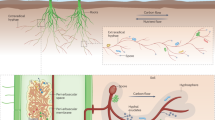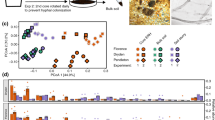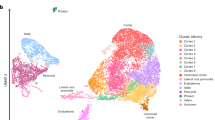Abstract
Arbuscular mycorrhizal fungi (AMF) are widespread root symbionts that perform important ecological services, such as improving plant nutrient and water acquisition. Some AMF from the Gigasporaceae family host a population of endobacteria, Candidatus Glomeribacter gigasporarum (Cagg). The analysis of the Cagg genome identified six putative toxin–antitoxin modules (TAs), consisting of pairs of stable toxins and unstable antitoxins that affect diverse physiological functions. Sequence analysis suggested that these TA modules were acquired by horizontal transfer. Gene expression patterns of two TAs (yoeB/yefM and chpB/chpS) changed during the fungal life cycle, with the expression during the pre-symbiotic phase higher than during the symbiosis with the plant host. The heterologous expression in Escherichia coli demonstrated the functionality only for the YoeB–YefM pair. On the basis of these observations, we speculate that TA modules might help Cagg adapt to its intracellular habitat, coordinating its proliferation with the physiological state of the AMF host.
Similar content being viewed by others
Log in or create a free account to read this content
Gain free access to this article, as well as selected content from this journal and more on nature.com
or
References
Akiyama K, Matsuzaki K, Hayashi H . (2005). Plant sesquiterpenes induce hyphal branching in arbuscular mycorrhizal fungi. Nature 435: 824–827.
Anca IA, Lumini E, Ghignone S, Salvioli A, Bianciotto V, Bonfante P . (2009). The ftsZ gene of the endocellular bacterium 'Candidatus Glomeribacter gigasporarum' is preferentially expressed during the symbiotic phases of its host mycorrhizal fungus. Mol Plant Microbe Interact 22: 302–310.
Audoly G, Vincentelli R, Edouard S, Georgiades K, Mediannikov O, Gimenez G et al. (2011). Effect of rickettsial toxin VapC on its eukaryotic host. PLoS One 6: e26528.
Bayles KW . (2014). Bacterial programmed cell death: making sense of a paradox. Nat Rev Microbiol 12: 63–69.
Bianciotto V, Bandi C, Minerdi D, Sironi M, Tichy HV, Bonfante P . (1996). An obligately endosymbiotic mycorrhizal fungus itself harbors obligately intracellular bacteria. Appl Environ Microbiol 62: 3005–3010.
Bianciotto V, Lumini E, Bonfante P, Vandamme P . (2003). ‘Candidatus Glomeribacter gigasporarum’ gen. nov., sp. nov., an endosymbiont of arbuscular mycorrhizal fungi. Int Syst Evol Micr 53: 121–124.
Bonfante P, Desirò A . (2017). Who lives in a fungus? The diversity, origins and functions of fungal endobacteria living in the Mucoromycota. ISME J e-pub ahead of print 7 April 2017 doi:10.1038/ismej.2017.21.
Gerdes K, Christensen SK, Løbner-Olesen A . (2005). Prokaryotic toxin–antitoxin stress response loci. Nat Rev Microbiol 3: 371–382.
Ghignone S, Salvioli A, Anca I, Lumini E, Ortu G, Petiti L et al. (2012). The genome of the obligate endobacterium of an AM fungus reveals an interphylum network of nutritional interactions. ISME J 6: 136–145.
Helaine S, Cheverton AM, Watson KG, Faure LM, Matthews SA, Holden DW . (2014). Internalization of Salmonella by macrophages induces formation of nonreplicating persisters. Science 343: 204–208.
Korch SB, Malhotra V, Contreras H, Clark-Curtiss JE . (2015). The Mycobacterium tuberculosis relBE toxin:antitoxin genes are stress-responsive modules that regulate growth through translation inhibition. J Microbiol 53: 783–795.
Lackner G, Moebius N, Partida-Martinez LP, Boland S, Hertweck C . (2011). Evolution of an endofungal lifestyle: deductions from the Burkholderia rhizoxinica genome. BMC Genomics 12: 210.
Leplae R, Geeraerts D, Hallez R, Guglielmini J, Drèze P, Van Melderen L . (2011). Diversity of bacterial type II toxin-antitoxin systems: a comprehensive search and functional analysis of novel families. Nucleic Acids Res 39: 5513–5525.
Lipuma J, Cinege G, Bodogai M, Olah B, Kiers A, Endre G et al. (2014). A vapBC-type toxin-antitoxin module of Sinorhizobium meliloti influences symbiotic efficiency and nodule senescence of Medicago sativa. Environ Microbiol 16: 3714–3729.
López-Madrigal S, Latorre A, Porcar M, Moya A, Gil R . (2011). Complete genome sequence of ‘Candidatus Tremblaya princeps’ strain PCVAL, an intriguing translational machine below the living-cell status. J Bacteriol 193: 5587–5588.
Lumini E, Bianciotto V, Jargeat P, Novero M, Salvioli A, Faccio A et al. (2007). Presymbiotic growth and sporal morphology are affected in the arbuscular mycorrhizal fungus Gigaspora margarita cured of its endobacteria. Cell Microbiol 9: 1716–1729.
Makarova KS, Wolf YI, Koonin EV . (2009). Comprehensive comparative-genomic analysis of type 2 toxin-antitoxin systems and related mobile stress response systems in prokaryotes. Biol Direct 4: 19.
Mruk I, Kobayashi I . (2014). To be or not to be: regulation of restriction-modification systems and other toxin-antitoxin systems. Nucleic Acids Res 42: 70–86.
Ohshima S, Sato Y, Fujimura R, Takashima Y, Hamada M, Nishizawa T et al. (2016). Mycoavidus cysteinexigens gen. nov., sp. nov., an endohyphal bacterium isolated from a soil isolate of the fungus Mortierella elongata. Int J Syst Evol Microbiol 66: 2052–2057.
Olah B, Kiss E, Gyorgypal Z, Borzi J, Cinege G, Csanadi G et al. (2001). Mutation in the ntrR gene, a member of the vap gene family, increases the symbiotic efficiency of Sinorhizobium meliloti. Mol Plant Microbe Interact 14: 887–894.
Pandey DP, Gerdes K . (2005). Toxin-antitoxin loci are highly abundant in free-living but lost from host-associated prokaryotes. Nucleic Acids Res 33: 966–976.
Partida-Martinez LP, Hertweck C . (2005). Pathogenic fungus harbours endosymbiotic bacteria for toxin production. Nature 437: 884–888.
Ramage HR, Connolly LE, Cox JS . (2009). Comprehensive functional analysis of Mycobacterium tuberculosis toxin-antitoxin systems: implications for pathogenesis, stress responses, and evolution. PLoS Genet 5: e1000767.
Salvioli A, Ghignone S, Novero M, Navazio L, Venice F, Bagnaresi P et al. (2016). Symbiosis with an endobacterium increases the fitness of a mycorrhizal fungus, raising its bioenergetic potential. ISME J 10: 130–144.
Schuster CF, Bertram R . (2013). Toxin-antitoxin systems are ubiquitous and versatile modulators of prokaryotic cell fate. FEMS Microbiol Lett 340: 73–85.
Sevin EW, Barloy-Hubler F . (2007). RASTA-bacteria: a web-based tool for identifying toxin-antitoxin loci in prokaryotes. Genome Biol 8: R155.
Smith SE, Read DJ . (2010) Mycorrhizal Symbiosis. Academic Press: London.
Uehling J, Gryganskyi A, Hameed K, Tschaplinski T, Misztal PK, Wu S et al. (2017). Comparative genomics of Mortierella elongata and its bacterial endosymbiont Mycoavidus cysteinexigens. Environ Microbiol 2017; e-pub ahead of print 11 January 2017; doi:10.1111/1462-2920.13669.
Vandamme P, Goris J, Chen WM, de Vos P, Willems A . (2002). Burkholderia tuberum sp. nov. and Burkholderia phymatum sp. nov., nodulate the roots of tropical legumes. Syst Appl Microbiol 25: 507–512.
Vannini C, Carpentieri A, Salvioli A, Novero M, Marsoni M, Testa L et al. (2016). An interdomain network: the endobacterium of a mycorrhizal fungus promotes antioxidative responses in both fungal and plant hosts. New Phytol 211: 265–275.
Acknowledgements
Research was funded by the local project, 60% to PB. Exchanges between Torino and Nice University were supported by the Italian-French PRES Agreement. The authors wish to express their thanks to Jennifer Mach for the language revision. They also thank Stefano Ghignone, Mara Novero and Veronica Volpe, as well as the RASTA software developers.
Author information
Authors and Affiliations
Corresponding author
Ethics declarations
Competing interests
The authors declare no conflict of interest.
Additional information
Supplementary Information accompanies this paper on The ISME Journal website
Supplementary information
Rights and permissions
About this article
Cite this article
Salvioli di Fossalunga, A., Lipuma, J., Venice, F. et al. The endobacterium of an arbuscular mycorrhizal fungus modulates the expression of its toxin–antitoxin systems during the life cycle of its host. ISME J 11, 2394–2398 (2017). https://doi.org/10.1038/ismej.2017.84
Received:
Revised:
Accepted:
Published:
Issue date:
DOI: https://doi.org/10.1038/ismej.2017.84
This article is cited by
-
Intricate Russian dolls relationships between plants, fungi and bacteria
Plant and Soil (2025)
-
Disentangling arbuscular mycorrhizal fungi and bacteria at the soil-root interface
Mycorrhiza (2023)
-
Gigaspora margarita with and without its endobacterium shows adaptive responses to oxidative stress
Mycorrhiza (2017)



